Mold infestation can be a major concern not only for the health of individuals but also for their belongings. Clothing items, in particular, are highly susceptible to mold growth due to their porous nature and tendency to retain moisture. The presence of mold on clothing can cause an unpleasant odor, discoloration, and even pose a risk of respiratory problems for individuals who come in contact with it. As a mold remediation specialist, I have witnessed firsthand the devastating effects of unchecked mold growth on clothing. In this article, I will provide you with effective methods on how to remove mold from clothing safely.
Mold removal from clothing is a delicate process that requires precision and care. It is essential to take adequate precautions to prevent further contamination during the removal process. Failure to eliminate all traces of mold can result in recurring growth, which can lead to significant damage to the fabric over time. In this article, I will outline step-by-step procedures on how to remove mold from clothing safely and effectively without causing any harm or damage to the fabric. Whether you are dealing with minor or extensive mold growth on your clothes, following these guidelines will ensure that your garments remain clean and safe for use once again.
Identifying Mold Growth On Clothing
Mold growth on clothing is a common problem that can lead to various health effects. Prevention methods are essential to avoid the growth of mold on clothes. The presence of humidity and moisture in the environment can cause mold growth on clothing, leading to foul odors and discoloration.
Prevention methods include keeping the environment dry and well-ventilated, especially in areas where clothes are stored or hung. It is essential to maintain proper cleanliness and hygiene by regularly washing clothes and drying them completely before storing them in cupboards or closets. Avoiding dampness and moisture is crucial to preventing mold growth on clothing.
Mold spores present on clothing can have adverse health effects, particularly for individuals with respiratory conditions such as asthma or allergies. Prolonged exposure to mold spores can lead to severe allergic reactions, respiratory infections, and other health issues. Understanding the health risks of mold on clothing is vital for taking appropriate measures to prevent its growth and ensure the safety of individuals wearing contaminated clothes.
Understanding The Health Risks Of Mold On Clothing
Mold exposure can cause a range of symptoms, such as nasal congestion, watery eyes, coughing, sneezing, throat irritation, and skin irritation. Allergies and infections can result from long-term exposure to mold, which may include severe allergic reactions, asthma attacks, and even fungal infections. To help prevent mold growth on clothing, it is important to reduce moisture, clean and dry clothing regularly, and avoid storing clothes in damp environments. Treatment for mold growth on clothing may involve laundering with hot water, freezing, sunlight exposure, or using a vinegar and water solution. If these treatments are unsuccessful, professional mold remediation may be necessary. It is important to seek medical help if experiencing any health issues due to mold exposure.
Symptoms Of Mold Exposure
Mold on clothing is a common problem that can lead to various health risks. As a mold remediation specialist, it is important to understand the symptoms of mold exposure in order to help prevent them. The health effects of mold exposure can range from mild allergic reactions to severe respiratory problems.
One of the most common symptoms of mold exposure is allergic reactions. These reactions can include sneezing, runny nose, red and itchy eyes, and skin rashes. If left untreated, these symptoms can worsen over time and lead to more serious respiratory problems such as asthma or bronchitis. It is important to take preventative measures in order to avoid these health risks.
Another symptom of mold exposure is the development of fungal infections on the skin or in the lungs. These infections can be particularly dangerous for individuals with weakened immune systems or pre-existing respiratory conditions. To prevent such infections from occurring, it is crucial to remove mold from clothing as soon as possible using safe and effective methods.
In conclusion, understanding the symptoms of mold exposure is essential for preventing potentially harmful health effects. As a mold remediation specialist, it is important to educate others about these risks and provide safe solutions for removing mold from clothing. By doing so, we can help ensure that individuals are not exposed to harmful toxins that may cause long-term damage to their health.
Allergies And Infections
The prevalence of mold-related allergies is a serious concern. As a mold remediation specialist, it is important to understand that people can experience various symptoms when exposed to mold on clothing. Allergic reactions are common, and they can range from mild to severe depending on the individual’s sensitivity. Symptoms include sneezing, runny nose, red and itchy eyes, and skin rashes.
The effects of mold exposure on respiratory health cannot be underestimated. People with pre-existing respiratory conditions or weakened immune systems are particularly vulnerable to developing fungal infections in the lungs or on the skin. These infections can be dangerous if left untreated and can lead to serious health complications. As a result, it is crucial to address mold growth on clothing as soon as possible using safe methods.
In conclusion, understanding the potential consequences of mold exposure is vital for preventing long-term health risks. As a mold remediation specialist, it is our responsibility to educate others about these dangers and provide effective solutions for removing mold from clothing safely. By doing so, we are helping individuals avoid harmful toxins that can have devastating effects on their overall well-being.
Prevention And Treatment
Preventing and treating mold growth on clothing is crucial to avoid adverse health effects. As a mold remediation specialist, it is essential to educate people about preventive measures to ensure that they are not exposed to harmful toxins. One way to prevent mold growth on clothing is by ensuring that clothes are cleaned and dried thoroughly before storage. Moisture is the leading cause of mold growth; therefore, clothes should be completely dry before being kept in a closet or drawer.
Another preventive measure is to store clothes in a well-ventilated area. Ventilation helps keep the air circulating, preventing moisture buildup, which reduces the likelihood of mold growth. It would also be helpful to use dehumidifiers in areas prone to high humidity levels such as basements and bathrooms.
In cases where mold has already grown on clothing, appropriate cleaning techniques must be employed. The first step is to remove the affected clothes from other garments to prevent cross-contamination. Clothes can be washed using hot water and detergent, and bleach can be used for white fabrics if necessary. If washing alone doesn’t remove the mold stains or if there are signs of severe damage, it may be best to discard the affected garment entirely rather than trying to salvage it.
Precautions To Take Before Removing Mold
Ironically, before diving into how to remove mold from clothing, it’s essential to discuss what you should do before removing the mold. Mold spores can easily spread throughout your home if not handled with care. Therefore, it’s crucial to take precautionary measures that will prevent further contamination.
Firstly, you must contain the affected area by isolating the mold-infected clothing and preventing it from spreading. You can do this by closing doors and windows of the room where the contaminated clothing is located. Moreover, using plastic sheets or tarps to seal off the area is a smart move.
Secondly, wear protective gear before handling any mold-infested clothes. Protective gear includes gloves, masks, and goggles that will cover all of your exposed skin. This equipment will protect you from inhaling harmful airborne particles during the removal process.
Lastly, clean up thoroughly after removing mold from your clothes. It’s vital to clean all surfaces with an appropriate disinfectant solution to kill any remaining spores that may have been left behind during removal. Additionally, dispose of any contaminated materials in sealed plastic bags to prevent further spread of mold spores.
- Preventing Spread: Close doors and windows of the affected area; use plastic sheets or tarps to seal off the room.
- Protective Gear: Wear gloves, masks, and goggles that cover all exposed skin.
- Disinfecting Surfaces: Clean all surfaces with an appropriate disinfectant solution after removal.
The next section will discuss tools and supplies needed for mold removal in more detail. Before moving on to this step, ensure that you have taken all necessary precautions as discussed above to avoid any risks while removing mold from your clothes.
Tools And Supplies Needed For Mold Removal
- Bleach is a common chemical used for mold removal, as it can be used to clean and disinfect hard surfaces.
- When removing mold, it is important to wear protective gloves to prevent skin contact with mold spores.
- Sponges, brushes and detergent can be used to scrub away mold from surfaces and clothing.
- Baking soda, white vinegar, ammonia and hydrogen peroxide are natural alternatives to bleach, and can be used to safely remove mold and mildew.
- To prevent further mold growth and spread, it is important to use a vacuum, fans and dehumidifiers to dry out affected areas.
- Mold remover, respirator masks and protective clothing should always be used when cleaning up mold, as exposure to mold spores can be harmful.
Bleach
As a mold remediation specialist, I understand the importance of removing mold from clothing safely. One of the most commonly used tools for mold removal is bleach. However, not all types of bleach are created equal. It’s important to use the right type of bleach to effectively remove mold without damaging your clothing.
There are two main types of bleach: chlorine bleach and oxygen bleach. Chlorine bleach is effective in killing mold and removing stains but can be harsh on certain fabrics and colors. Oxygen bleach, on the other hand, is gentler and works well on colored fabrics but may not be as effective in removing tough stains. When using bleach for mold removal, it’s important to carefully read the label and follow all safety precautions.
If you’re looking for an alternative to bleach for removing mold from clothing, there are several options available. Vinegar is a natural disinfectant that can be effective in killing mold spores. Simply mix equal parts vinegar and water in a spray bottle and apply to affected areas before washing as usual. Tea tree oil is also a natural antifungal agent that can be added to your regular laundry detergent for an extra boost of mold-fighting power. Ultimately, the key to safe and effective mold removal from clothing is choosing the right tools and supplies for the job at hand.
Gloves
As a mold remediation specialist, I understand that using proper protective gear is crucial when removing mold from any surface, including clothing. Gloves are one of the most essential tools needed for mold removal. They protect your hands from coming into direct contact with mold spores and other harmful materials. It’s important to choose gloves made of durable and puncture-resistant material to ensure maximum protection.
When using gloves for mold removal, it’s important to follow certain guidelines to ensure their effectiveness. First, make sure the gloves fit snugly and are not too loose or too tight. This will prevent them from slipping off or tearing during use. Secondly, avoid touching your face or other parts of your body while wearing the gloves to prevent contamination. Lastly, dispose of the gloves properly after use as they may be contaminated with mold spores and other harmful materials.
In addition to gloves, there are other tools and supplies needed for safe and effective mold removal from clothing. These include protective eyewear, masks or respirators, cleaning solutions specifically designed for mold removal, and bags for disposing of contaminated materials. By using these tools and supplies properly and following safety guidelines, you can effectively remove mold from clothing without risking your health or damaging the fabric.
Sponges
As a mold remediation specialist, understanding the importance of using proper tools and supplies is crucial when removing mold from any surface. Aside from gloves, there are other materials required to ensure a successful and safe mold removal process. One of these materials includes sponges, which are commonly used during cleaning procedures. However, for individuals who have allergies or sensitivities to latex, sponge alternatives must be considered.
There are several sponge alternatives available that provide the same level of efficiency as traditional sponges. These alternatives include microfiber cloths, nylon scrubbers, and cellulose sponges made from natural materials such as wood pulp or cotton. It’s important to note that some cellulose sponges may contain small amounts of latex, so it’s essential to read the product labels carefully before use.
Regardless of the type of sponge being used during the mold removal process, safety precautions must be followed to prevent cross-contamination and ensure personal protection. Sponges should be regularly sanitized with hot water and an appropriate cleaning solution. Additionally, disposable gloves should always be worn while using sponges to minimize contact with mold spores and other harmful substances. By following these guidelines when utilizing sponge alternatives or traditional sponges for mold removal from clothing, you can successfully eliminate all traces of mold without putting your health at risk.
Preparing Your Work Area
Before starting any mold remediation project, it is important to prepare your work area. This means clearing out any clutter and removing any items that could be potentially contaminated with mold spores. It is also important to choose the appropriate cleaning products before beginning the mold removal process.
Clearing clutter from your work area will not only make the process easier but will also help prevent cross-contamination of other areas in your home. Be sure to remove any objects from the room that are not necessary for the cleaning process, including furniture, decor, and appliances. It is also crucial to properly seal off the work area to prevent mold spores from spreading throughout your home.
Choosing appropriate cleaning products is key when removing mold from clothing. It is recommended to use a non-toxic cleaner such as vinegar or hydrogen peroxide mixed with water. Avoid using bleach as it can damage some fabrics and may not effectively kill all types of mold. Additionally, be sure to wear gloves and a mask while handling cleaning products to protect yourself from potential health hazards.
Transitioning into the subsequent section on removing mold from washable clothing, it is important to note that different types of fabric may require different cleaning methods. Therefore, it is essential to identify the type of fabric before proceeding with any cleaning techniques.
Removing Mold From Washable Clothing
After preparing your work area, it’s time to start dealing with the mold on your washable clothing. One of the most effective ways to remove mold from clothing is by using natural remedies. These are typically safer for both you and your clothes since they do not contain harsh chemicals that can damage fabrics.
One such natural remedy is white vinegar. Simply add a cup of white vinegar to the washing machine along with your regular laundry detergent and run a normal cycle. Alternatively, you can soak the affected clothing in a mixture of water and vinegar for about an hour before washing as normal. Another natural remedy is tea tree oil, which has antifungal properties that make it effective against mold spores. Add a few drops of tea tree oil to your laundry detergent or directly onto the affected areas before washing.
If natural remedies do not work, you can also use mold removers specifically designed for clothing. It’s important to choose one that is safe for both colored and delicate fabrics, so be sure to read the label carefully before use. Follow the instructions provided by the manufacturer closely and avoid overusing the product since this can lead to fabric damage.
Moving forward, removing mold from non-washable clothing requires different techniques since these items cannot be washed in a machine or soaked in water. However, there are still effective ways to get rid of mold on these types of garments without causing further damage.
Removing Mold From Non-Washable Clothing
- Vacuuming is an effective method to remove mold spores from non-washable clothing. It is important to use a vacuum with a HEPA filter to prevent the spread of spores into the air.
- Spot cleaning is a method that can be used on small areas of mold on non-washable clothing. The most effective spot cleaning method is to use a mold-killing detergent and a brush or scrubbing pad.
- Freezing is a method that can be used to kill mold spores on non-washable clothing. The clothing needs to be placed in the freezer for at least 24 hours.
- After using any of the above methods, it is important to inspect the clothing for any remaining mold before wearing.
- If any mold remains after using the vacuum, spot cleaning, and freezing methods, the clothing should be discarded to prevent the spread of mold spores.
- If any of the above methods are used to remove mold from non-washable clothing, it is important to properly dispose of the materials used to ensure that the mold spores do not spread.
Vacuuming
When dealing with mold on non-washable clothing, vacuuming is a safe and effective option. Using a vacuum for mold removal can help to remove the spores from the fabric without damaging it. It is important to use a HEPA filter vacuum to ensure that the spores do not spread throughout the home during the cleaning process.
To properly vacuum mold from clothing, start by placing the garment in a plastic bag and sealing it tightly. This will prevent any spores from escaping and spreading to other areas of your home. Then, using a soft-bristled brush attachment, gently brush the surface of the clothing to loosen any visible mold spores. Next, carefully vacuum each area of the garment with short overlapping strokes until all visible mold has been removed.
After removing mold with a vacuum, be sure to clean it thoroughly. Using bleach or disinfectant wipes, wipe down all surfaces that came into contact with the contaminated fabric, including hoses and attachments. Allow these items to air dry completely before using them again. Properly cleaning your vacuum after removing mold is essential in preventing cross-contamination and ensuring that your home remains free of harmful spores.
Spot Cleaning
Preventing mold growth is essential in maintaining a healthy living environment. This includes proper laundry techniques for non-washable clothing that has been contaminated with mold. While vacuuming is an effective way to remove the spores, some areas may require spot cleaning for more thorough removal.
Spot cleaning involves using a gentle cleaner and a soft-bristled brush to clean the affected area of the garment. It is important to choose a cleaner that will not damage the fabric and that has anti-microbial properties. Bleach should be avoided as it can weaken the fibers of the clothing and cause further damage. After spot cleaning, allow the garment to air dry completely before wearing or storing.
In addition to spot cleaning, it is important to take preventative measures to avoid future mold growth on non-washable clothing. Proper storage in a cool, dry place can help prevent moisture buildup which leads to mold growth. Regularly inspecting clothing for signs of mold and promptly addressing any issues can also help prevent further contamination. By following these techniques, you can ensure that your home remains free of harmful mold spores and maintain a healthy living environment.
Freezing
As a mold remediation specialist, it is essential to provide effective solutions for removing mold from non-washable clothing. While spot cleaning can be an effective method for removing visible mold growth, it may not always be enough to prevent recontamination. This is where alternative methods such as freezing come into play.
Freezing is a technique that involves placing the affected clothing in a sealed plastic bag and placing it in the freezer for at least 24 hours. The extreme cold temperatures will kill any remaining mold spores, preventing them from spreading and causing further contamination. Once removed from the freezer, allow the garment to thaw completely before inspecting for any remaining signs of mold.
Preventing recontamination is important when dealing with mold on non-washable clothing. Proper storage in a cool, dry place can help prevent moisture buildup which leads to mold growth. It is also important to regularly inspect clothing for signs of mold and promptly address any issues. By incorporating alternative methods like freezing, you can ensure that your home remains free of harmful mold spores and maintain a healthy living environment for yourself and those around you.
Treating Stubborn Mold Stains
You may have tried different methods to eradicate mold stains on your clothes but still, there are some stubborn spots that just won’t go away. Don’t worry, as a mold remediation specialist, I have seen it all and I’m here to tell you that there are still ways to treat those pesky stains. One solution is using hydrogen peroxide which is known for its ability to remove even the toughest mold stains.
To use hydrogen peroxide, mix equal parts of it with water then apply it directly onto the stained area. Let it sit for an hour or more then rinse thoroughly with cool water. If the stain persists, repeat the process until it’s completely gone. However, be cautious as too much exposure to hydrogen peroxide can cause discoloration on certain fabrics.
If you prefer eco-friendly solutions, vinegar can also be a great alternative in removing mold stains on your clothes. Mix one part vinegar with three parts of warm water then soak your clothing in the solution for at least 30 minutes before washing them as usual. This method not only removes stubborn stains but also helps in preventing recontamination from happening.
Now that you have learned how to treat stubborn mold stains on your clothing, the next step is drying and inspecting them properly. It’s important to make sure that they are completely dry before storing them back in your closet or drawers as moisture can encourage mold growth. Inspect each piece carefully for any remaining mold spots and repeat the cleaning process if necessary. By following these steps, you can say goodbye to those annoying mold stains and enjoy fresh-smelling clothes once again!
Drying And Inspecting Clothing After Mold Removal
After successfully removing mold from clothing, it is important to properly dry and inspect the items before storing them. One of the most effective ways to dry clothing after mold removal is by hanging them outside in direct sunlight. Sunlight helps to kill any remaining spores and also removes any moisture that may have been left behind during the cleaning process.
Inspecting techniques are crucial after mold removal as they ensure that all traces of mold have been removed from the clothing. One method for inspecting clothing is by using a black light. This type of light can reveal any remaining mold stains that may not be visible to the naked eye. Additionally, thoroughly checking seams, cuffs, collars, and other hard-to-reach areas can help ensure that no mold has been left behind.
Proper storage is essential in preventing any future mold growth on cleaned clothing. It is recommended to store clothes in a dry, cool area with good ventilation. Avoid packing clothes tightly together as this can create an environment for mold growth. Using moisture absorbers such as silica gel packets or activated charcoal can also help keep clothes dry and free from mold growth.
To prevent future mold growth on clothing, there are several tips one could follow such as washing clothes regularly, avoiding damp storage areas, and promptly drying wet clothes. These simple steps can go a long way in preventing future occurrences of mold growth on your clothing.
Tips For Preventing Future Mold Growth On Clothing
Preventing future mold growth on clothing is crucial in maintaining a healthy and safe living environment. There are several ways to prevent mold growth, starting with proper ventilation. Make sure that your closet is well-ventilated by keeping the door open for at least an hour each day. This will allow fresh air to circulate and help prevent moisture buildup.
Another way to prevent mold growth is by storing clothes properly. Avoid packing clothes too tightly in a closet or drawer, as this can trap moisture and create an ideal environment for mold spores to grow. Instead, hang clothes on hangers or use storage containers with breathable materials such as canvas or cotton.
Lastly, take care of your clothing by washing and drying them properly. Always follow the care instructions on the label and avoid leaving wet clothes in the washing machine for long periods. It’s also important to thoroughly dry clothes before putting them away, as damp clothes can easily develop mold.
• Regularly clean your closet and drawers using a non-toxic cleaning solution. • Monitor humidity levels in your home and use a dehumidifier if necessary. • Do not store wet or damp clothing. • Consider using natural anti-microbial products such as vinegar or tea tree oil to eliminate mold spores. • Store seasonal clothing in sealed containers with moisture-absorbing packets.
Preventing mold growth on clothing requires proactive measures that may seem time-consuming but are ultimately beneficial for your health and safety. By following these tips, you can ensure that your clothes remain free from harmful mold spores while maintaining their quality and longevity. In the next section, we will discuss when it’s best to seek professional help for mold removal.
When To Seek Professional Help For Mold Removal
Mold infestations that are large in scope and difficult to control should be handled by a mold remediation professional. Health risks associated with certain types of mold, especially black mold, can be severe and warrant professional attention. Identifying the type of mold present can be difficult and require a professional for proper removal. Additionally, mold remediation professionals will have the specialized tools and knowledge needed to properly remove the mold. Furthermore, a professional may be the best option for sensitive areas such as those containing electronic devices, fabrics or foodstuffs. Lastly, a professional will be able to provide the necessary advice on how to safely remove mold from clothing.
Large Infestations
When dealing with large infestations of mold on clothing, it is crucial to seek professional help from certified mold removers. Attempting to remove the mold yourself may lead to further contamination and health risks. Professional mold removers have the necessary equipment and expertise to properly handle large infestations and ensure that all traces of mold are removed.
Hiring professional mold removers for large infestations is especially important because these situations often require specialized techniques such as dry cleaning or ozone treatments. These methods are highly effective in removing mold from clothing without causing damage or discoloration. Attempting these techniques without proper training can lead to irreparable damage to your clothes.
In addition to protecting your clothing, hiring professional mold removers for large infestations also ensures that your home and family remain safe from potential health hazards associated with exposure to mold spores. Mold can cause respiratory issues and allergic reactions in some people, so it is important to address any infestation promptly and thoroughly. With the help of a certified mold remediation specialist, you can be confident that your home is free from harmful levels of mold.
Health Risks
Mold exposure can lead to a range of health effects, particularly when it comes to respiratory issues and allergic reactions. When an infestation of mold is present in your home, it’s important to seek professional help for mold removal as soon as possible to minimize the risk of these health impacts. As a mold remediation specialist, I have seen firsthand how mold can affect people’s health and wellbeing, which is why I strongly recommend seeking expert assistance when dealing with mold.
Professional mold removers are equipped with the knowledge and tools necessary to safely remove mold from your home, minimizing the risk of exposure and potential health issues. Attempting to remove mold on your own can be dangerous, particularly if you don’t have the right equipment or expertise. It’s always best to leave this job to the experts so that you can be sure that your family is safe from harm.
In summary, if you suspect that there may be a significant amount of mold in your home or clothing, it’s crucial to seek professional help for mold removal. This will not only protect your belongings but also keep you and your family safe from potential health risks associated with exposure to mold spores. Don’t hesitate – contact a certified mold remediation specialist today for expert assistance with all your mold removal needs.
Unidentifiable Mold
As a mold remediation specialist, I have come across cases where homeowners are unsure if they have mold in their homes. Some molds can be easily identified by their appearance and smell, while others can be difficult to detect. Unidentifiable mold is a common problem that many homeowners face, and it’s important to seek professional help for mold removal.
Professional mold removers use specialized cleaning methods to remove unidentifiable mold from your home. They also take safety precautions to ensure that the process is done safely and effectively. Attempting to remove unidentifiable mold on your own can be dangerous, as you may not know what type of mold you’re dealing with or how to effectively remove it.
If you suspect that there may be unidentifiable mold in your home, it’s crucial to seek professional help for mold removal. A certified mold remediation specialist has the expertise and tools necessary to properly identify and safely remove any type of mold from your home. Don’t wait until it’s too late – contact a professional today for expert assistance with all your mold removal needs.
Common Misconceptions About Mold Removal From Clothing
Despite the common misconceptions about mold removal from clothing, it is possible to effectively remove mold from your garments without damaging them. In fact, according to recent studies, mold can grow on almost any type of fabric in the right conditions. This means that it is essential to know how to safely remove mold from your clothing to prevent potential health risks.
One of the most effective solutions for removing mold from your clothes is washing them with a mixture of vinegar and baking soda. This solution has been proven effective in removing mold stains and eliminating odor-causing bacteria. However, it is crucial to note that this method may not work for severe cases of mold infestation.
Another common misconception about removing mold from clothes is that bleach is an efficient solution. While bleach can help remove some types of mold stains, it should only be used as a last resort and with caution. Bleach can damage certain fabrics and cause discoloration, so it’s best to test a small area first before using it on all your clothes.
It’s important to remember that DIY mold removal on clothing comes with potential risks. Without proper knowledge and equipment, attempting to remove mold yourself could lead to further contamination or health hazards. It’s always recommended to seek professional help if you’re unsure or dealing with extensive damage. Don’t put yourself at risk – reach out for assistance from a qualified specialist who can safely remove the mold from your clothing while ensuring that your health remains uncompromised.
Potential Risks Of Diy Mold Removal On Clothing
DIY mold removal on clothing may seem like an easy and cost-effective solution to the problem. However, it is crucial to note that DIY methods are not as effective as professional mold remediation. Mold spores are microscopic and can easily become airborne when disturbed, leading to further contamination. Also, DIY methods only address the visible mold on the surface of the clothing and may not eliminate the spores that have embedded deep within the fibers.
The health risks of prolonged mold exposure cannot be overstated. Exposure to mold can cause a range of health problems such as allergies, asthma, respiratory infections, and skin irritation. The symptoms of mold exposure can worsen over time if left untreated. Therefore, it is essential to take a proactive approach when dealing with mold growth in your home or belongings.
It is always advisable to seek professional help when dealing with mold growth in your home or clothing. Professional mold remediation specialists have the necessary equipment and expertise to identify and eliminate all traces of mold from your clothing safely. This ensures that you do not risk further contamination or exposure to harmful toxins present in some types of mold.
Frequently Asked Questions About Removing Mold From Clothing
Preventing mold growth in the first place is the best way to avoid having to deal with it on your clothing. To achieve this, you should always ensure that your clothes are completely dry before storing them away. If you have damp or wet clothes, it’s crucial to hang them up to dry immediately. Additionally, you should always make sure that your closet has adequate ventilation and air circulation.
When dealing with mold on clothing, there are several cleaning techniques that can be used safely. One common method is to use a mixture of white vinegar and water, which can be applied directly to the affected area using a cloth or sponge. Another popular cleaning agent is baking soda, which can be mixed with water into a paste and applied directly onto the moldy area.
In conclusion, staying safe and mold-free involves taking preventative measures such as ensuring proper ventilation and air circulation in storage spaces for clothing. When faced with mold on clothing, there are various cleaning techniques that can be utilized effectively without compromising safety. By following these guidelines, you can keep your clothing clean and free from harmful mold spores.
Conclusion: Staying Safe And Mold-Free
As the saying goes, prevention is better than cure. When it comes to mold, preventing its growth is the key to staying safe and healthy. However, if you already have mold on your clothing, it’s important to remove it safely to avoid health hazards.
Here are some tips for removing mold from clothing safely:
- Wear protective gear such as gloves and a mask to prevent inhaling mold spores.
- Wash the affected clothing in hot water with detergent and add a cup of white vinegar or baking soda to the wash cycle.
- If the mold stains are stubborn, use a commercial mold remover specifically designed for clothing.
- Dry the clothing thoroughly in direct sunlight or using a dryer on high heat.
It’s important to note that if the mold has spread extensively on your clothing, it may be best to dispose of them altogether. Mold spores can cause respiratory problems and other health hazards if left unchecked.
As a mold remediation specialist, my goal is not just to remove existing mold but also to educate people on how to prevent its growth in the first place. Simple steps like keeping your home well-ventilated and controlling moisture levels can go a long way in preventing mold growth. By staying vigilant and taking action promptly when you notice any signs of mold growth, you can protect yourself and your loved ones from potential health hazards.
Conclusion
Mold growth on clothing is a common problem that can lead to unpleasant odors, stains, and health risks. As a mold remediation specialist, it is crucial to understand the proper techniques for safe mold removal from clothing. Before beginning any mold removal process, identify the affected areas and take appropriate precautions to protect yourself and others.
The tools and supplies needed for mold removal from clothing include gloves, masks, detergent, vinegar or bleach solutions, and a washing machine with hot water settings. It is essential to prepare your work area by laying out tarps or plastic sheeting to avoid contaminating other surfaces. Common misconceptions about mold removal from clothing include using only bleach solutions or hanging clothes outside in the sun as a remedy. However, these methods are not always effective and may even worsen the problem.
DIY mold removal on clothing poses potential risks such as inhaling harmful spores or improperly cleaning contaminated items. It is best to seek professional help if you are unsure of how to approach the situation safely. Frequently asked questions about removing mold from clothing include how long it takes for clothes to dry after treatment and whether vinegar or bleach is more effective. Ultimately, staying safe and mold-free requires proper identification, precautionary measures and appropriate supplies for successful remediation.
In conclusion, removing mold from clothing is a task that should not be taken lightly due to its potential health hazards. As with any remediation process, it is crucial to take adequate precautions before starting work by preparing your workspace appropriately and using protective gear throughout the process. Think of this process like doing surgery on contaminated garments: precise planning results in accurate execution which ultimately leads to success!
Image Credits
- “Black mold in my shower” by ericabiz (featured)

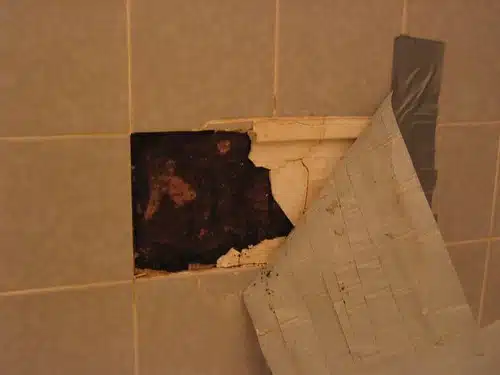









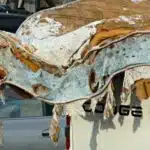
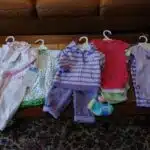




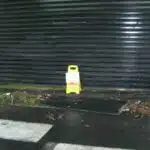



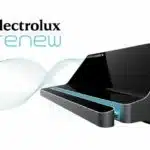
![How To Remove Perfume Odors From Clothes 22 For pungency, strength, durability and delicacy of odor. Read's Grand Duchess Cologne. [back]](https://green-life.blog/wp-content/uploads/2023/05/b-myfoHrx-jq-150x150.jpg.webp)





![How To Wash And Care For White Clothes 28 The only genuine borax soap cleanses hygienically saves the clothes and hands. 20 Mule-Team brand Boraxo white laundry soap [front]](https://green-life.blog/wp-content/uploads/2023/05/YDXLLCovnOjq-150x150.jpg.webp)
